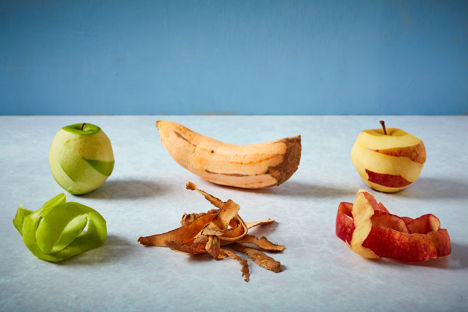
Waste away: skins and peels
Don’t throw those fruit and vegetable peelings in the bin – there are plenty of ways to incorporate them into your cooking. Victoria Glass shows us how, and shares her three favourite recipes that make the most of them.
Waste away: skins and peels
Don’t throw those fruit and vegetable peelings in the bin – there are plenty of ways to incorporate them into your cooking. Victoria Glass shows us how, and shares her three favourite recipes that make the most of them.
If I peered my sticky beak into most food waste caddies across the country, I’d wager the bulk of their contents would be made up of fruit and vegetable skins. Potato and carrot peelings, banana skins and squeezed out citrus fruits won’t necessarily inspire most people to think beyond the compost heap, but there is a world of flavour and thrifty domestic maintenance waiting to be uncovered.
People too often reach for the peeler when a quick scrub would do, but there’s no denying that there are times when skins-off is the only way to go. Mashed potato is a case in point; it absolutely must be smooth and creamy to hit the spot, and freckled chunks of skin just won’t cut the mustard. It might be better for you, but I’d rather take silky comfort over added fibre here, but it doesn’t mean those potato skins should be given a one-way ticket to the bin. They can be saved and tossed in oil and salt, along with some extra flavours if you like (paprika, cumin, chopped rosemary, or even good old malt vinegar), then deep-fried or baked in a hot oven for twenty minutes.
You can do the same with parsnip and carrot skins (though check after ten minutes for carrots), or long ribbons of pumpkin skin. After a Sunday roast you can use up all your veg peelings to make my pakoras on Monday. Even tough-as-old-boots butternut squash skins need not be wasted; if you chop them finely, they can be cooked down to make fantastic chutneys, or used alongside lemon or lime rinds or mango skin to make fragrant Indian mixed pickle.
I usually prefer my apples and pears unpeeled (even in tarts), but my three-year-old often has other ideas. If I’m left with a chopping board full of apple peel, I like to slice it up finely to add to slaws – it works really well with red cabbage and beetroot. If you don’t want to use them straight away, try dehydrating apple and pear skins in a low oven for about an hour to add to muesli. You can also try boiling up fruit skins with a little sugar and water, plus a squeeze of lemon juice, to make lovely homemade squash, ready to be diluted with water or added to cocktails.
It’s always a shame to waste citrus peel, so I mostly try to rescue the zest before juicing to use later. Aside from candied peel and adding to cakes and puddings, a chef friend recently suggested I try coating strips of lemon zest in salt before leaving them to ferment for a few days at room temperature, and it has been a revelation chopped up and tossed in zingy salads or through strings of spaghetti. I like to dehydrate strips of orange zest for homemade shichimi togarashi, but on days when I forget to pre-zest, I’ve found uncooked syrups from old squeezed out lemons, limes or grapefruits are effortless ways to keep some sunshine in your fridge whatever the weather. Simply chop up the rinds, cover with sugar and stir them every hour, or so, until all the sugar has dissolved, then mash them down to release more of the oil in the skins, before discarding the rinds and bottling. It also works with pineapple skins. Another fantastic use for fruit skin and cores is to make homemade vinegars.
Orange rinds can be steeped in white vinegar to make a brilliant household cleaning spray that won’t leave your house smelling like a chip shop and even banana skins can have life beyond setting up comedy falls on pavements. They are a natural way to repel aphids, so try chopping them up and adding them to the soil around your vulnerable plants, or try using them to wipe the leaves of houseplants to clean off any dust. You can also try making an infusion from banana skins by steeping them in hot water; I have to admit that it’s not my cup of tea, but I have friends who can’t get enough of the stuff.
Food and drink accounts for twenty percent of the UK’s CO₂ eq (carbon dioxide equivalent) emissions. WRAP (Waste and Resources Action Programme) revealed that an estimated 7.3m tonnes of household food waste was thrown away in 2015, and of that 7.3m tonnes, 4.4m tonnes was deemed to be ‘avoidable’ (e.g. food that was edible at some point before it was thrown away, such as loaves of bread). The knock-on effect was that the average UK household wasted £470 worth of edible food. This avoidable food waste will generate 19m tonnes of greenhouse gases and, if we could prevent that pollution, it would be equivalent to taking one in four cars off UK roads.But, this ‘avoidable’ food waste doesn’t include things like peelings or squeezed out citrus rinds, so just imagine what we could achieve (not to mention how much money we’d all save) if we started getting more creative with every last drop of all our ingredients. It’s certainly no hardship when they taste this good.

